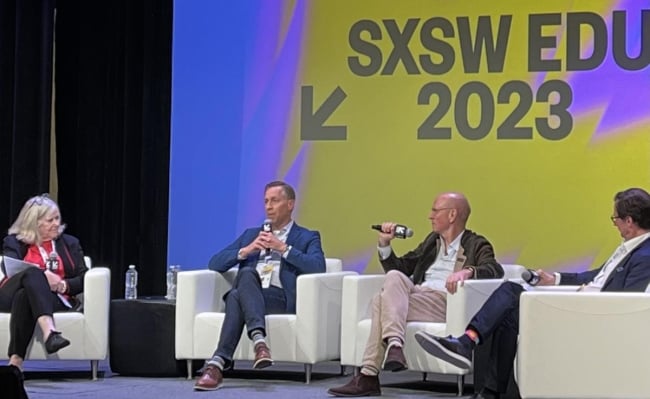You have /5 articles left.
Sign up for a free account or log in.

“In the federal student aid model, you’re financing the consumption of credit rather than the delivery of value,” Scott Pulsipher, Western Governors University president, said.
Susan D’Agostino for Inside Higher Ed
AUSTIN, Tex.—About a decade ago, nearly all—97 percent—of IBM’s job advertisements required a four-year college degree, according to David Barnes, vice president of global workforce policy at the tech giant, who spoke this week at the annual SXSW EDU conference here. That requirement disqualified the approximately two-thirds of Americans in the labor pool without degrees from applying for jobs at IBM, Barnes said. As a result, IBM struggled with significant, sustained hiring shortfalls.
“We decided to indulge in some self-help,” Barnes said. “We call it skills-first hiring.” First, IBM hiring managers had to erase some biases they had about candidates who had not earned college degrees. Next, they assessed job candidates for the skills they possessed and their abilities to learn new skills, regardless of degree status. Also, the company invested heavily in an online employee education learning platform.
“It’s driven by artificial intelligence,” Barnes said of IBM’s training and reskilling effort. “It’s a Netflix-like interface that pushes content. Or an employee can select content … We can’t use Charles Dickens learning models anymore.” Today, fewer than half of IBM’s job ads mandate a college degree. The company is now better positioned, Barnes said, to maintain its global lead in quantum computing—technology that holds the potential to revolutionize computing power.
Barnes and other academic and industry leaders spoke with conviction and passion during the “Online Backlash: Bad Policy Holds Students Back” panel at SXSW EDU. The leaders discussed the ways in which colleges, policy makers and employers might work together to help more Americans find or advance in viable employment, while also addressing the workforce skills gap. But some “bad” policies and attitudes about online learning undermine their efforts to work together, expand access and deliver outcomes to motivated, capable learners.
‘Bad’ Policy No. 1: Separate Education and Training
IBM is not the only company that has pivoted in response to societal dissatisfaction with traditional college degrees. Cengage, a textbook publisher for over 130 years, now offers educational experiences that lead to certificates and certifications, according to Michael Hansen, CEO of Cengage Group.
“Employers were saying, ‘We have job openings we can’t fill, and we want to work with the education system, but it is so unbelievably frustrating because they’re very rigid, and they don’t want to customize to our needs,’” Hansen said. These employers sought workforce training that could produce a pipeline of learners-turned-employees, and Hansen said they told him, “If you can do that, I’ll pay you.”
In response, Cengage produced online educational experiences that lead to certificates for in-demand jobs. The typical student is a 40-something woman with an income of approximately $45,000 looking to re-enter the workforce or grow in her career, Hansen said. Today, this Cengage initiative enrolls approximately 250,000 individuals annually, which comprises 10 percent of the company’s business. Hansen projects this will grow to over 30 percent within a few years.
“The first bad policy is that [higher ed] separates education and training,” Jane Oates, president of Working Nation and panel moderator, said. “We call them very separate things, and some [in higher ed] don’t even like use the word ‘train.’”
To be sure, some higher ed institutions embrace the notion that educational experiences should have market value. Western Governors University, for example, offers stackable, workplace-relevant credentials.
“We kind of live by this mantra that a credential with no market value is just a scam,” said Scott Pulsipher, president of Western Governors and another speaker on the panel. “It doesn’t matter whether you’re acquiring knowledge through an academic pathway or whether you’re acquiring that through an experiential pathway or through a work pathway. At the end of the day, it’s still, ‘what capability do you have, and how well does that capability align with what’s needed in the workforce and in a particular role?’”
‘Bad’ Policy No. 2: Assuming Online Learning is ‘Second Best’
Some policy makers, perhaps based on earlier efforts to root out for-profit online institutions that were seen as abusing federal financial aid programs, may continue to view online education as a “stepchild” in the higher ed ecosystem, according to Oates. Such a view is unwarranted given strides in developing and understanding best online practices, especially during the pandemic, Oates said.
“It’s a red herring if you focus on mode, method or model of instruction,” Pulsipher said. “Good policy would actually advance and incentivize delivery against outcomes, not inputs.” Yet some federal policy governing virtual learning, such as regular and substantive interaction with instructors in online courses, relies on inputs to determine quality, Pulsipher said. He suggests that policy makers ask questions about whether students are gaining mastery in a subject, completing credentials and getting jobs.
One panelist pushed back even harder against the notion that in-person learning is best.
“Online learning is the only way to get learning to scale,” Barnes said, adding that the half-life of his employees’ technical skills is approximately three years. “We could not keep our employees contemporary in any other way. We wouldn’t spend $300 million on online learning every year if it didn’t work.”
Successful IBM job candidates who are hired without college degrees may pursue apprenticeships at the company in fields such as cybersecurity, cloud computing, artificial intelligence and digital design. The apprenticeships have online learning components, and many offer opportunities to earn college credits through the American Council on Education. Ninety percent of the more than 1,000 individuals who have completed IBM-sponsored apprenticeships have become full-time IBM employees, and over 40 percent hail from underrepresented minority groups, Barnes said. Not requiring a college degree upon hiring has improved the company’s efforts to hire and retain a diverse workforce.
“They have a real hunger and a real intensity about succeeding in a job which they thought they did not have a pathway to,” Barnes said. “The people who come down these pathways are incredibly loyal.” The program has been very good for IBM, too, which is why it has invested over $250 million in its apprenticeship programs through 2025, Barnes said.
“You have to have the capacity to understand both talent and potential,” Ruth Simmons, President’s Distinguished Fellow at Rice University, said in her keynote talk. Though Simmons’s talk addressed higher education and American democracy, she echoed some themes in the “bad policy” panel. Simmons, who is president emerita of Smith College and Brown University, currently serves as senior adviser to the president of Harvard University on engagement with historically Black colleges and universities, among other national higher ed leadership positions. “If you understand both [talent and potential] and you don’t have narrow perceptions of what human being can do, you can take flight in all kinds of ways.”
Online college credit earned in an apprenticeship like those at IBM could be transferred to a college, should the learner ultimately want to pursue a college degree. But some colleges construct barriers to accepting transfer credit, possibly to maximize their revenue, Pulsipher said.
“In the federal student aid model, you’re financing the consumption of credit rather than the delivery of value,” Pulsipher said.
Barnes made a plea for higher education leaders to think less about inputs and more about outputs that, in his view, students and employers want.
“As an employer, we don’t measure ourselves by what we spend,” Barnes said. “We measure ourselves by what we create, what we produce, what we deliver and whether it’s quality.”
But Hansen had a different take on the apparently misaligned priorities.
“A lot of people say the education system is broken in the United States,” Hansen said. “It’s not broken. It does exactly what it’s designed to do, which is create degree recipients. It’s our job to challenge that and say maybe there need to be alternatives.”




